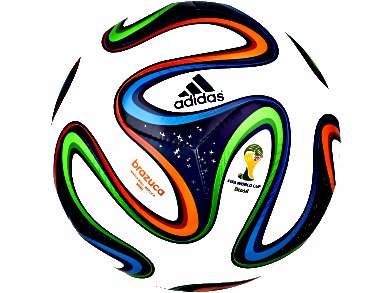Brazuca, the World Cup football 2014, weighs 437 g and is mainly made out of polyurethane. It is the result of the collaboration regarding ball development of the German based companies adidas, Herzogenaurach, and Bayer MaterialScience, Leverkusen, since 1986.
Surface Panels
The surface of Brazuca is made up of only six panels of absolutely identical shape. Conventional soccer balls consist of 12, 16, or 32 panels stiched together. Besides leading to perfect symmetry, the reduced number of panels of Brazuca requires fewer seams. This means that the ball is more durable and absorbs less moisture (only 0.2 %) which makes Brazuca lighter than other balls when played on wet ground.
The six panels are bonded together using a patented thermobonding technology.
Skin
Brazuca has five polyurethane layers which make for its uniqueness. The outer layer of the skin comprises three compact layers of polyurethane each with different thicknesses. They are responsible for the outstanding resistance to external influences and abrasion, and for the ball’s high elasticity.
The innermost layer of the skin is an adhesion coating that connects the textile substrate to the layers above. On top of this is a roughly 1 mm thick polyurethane foam layer which is made up of millions of gas-filled microspheres. This foam is highly elastic so that the ball, after being deformed from being kicked, immediately returns to its spherical shape to ensure an optimal trajectory.
Bladder
The bladder in the middle of the ball holds the air. Brazuca’s bladder is made out of latex.
- Bayer MaterialScience, Leverkusen, Germany
Also of interest:
- The Science of Football,
ChemViews Mag. 2012.
DOI: 10.1002/chemv.201200063




